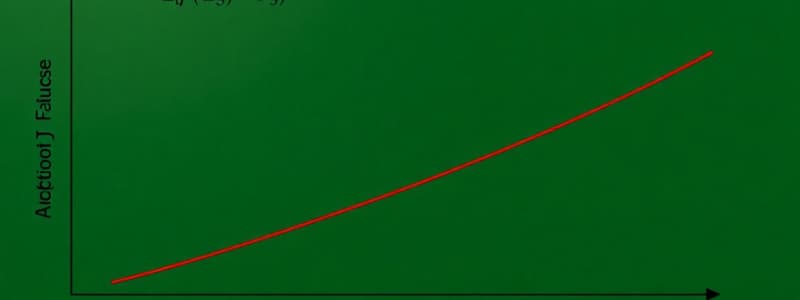Podcast
Questions and Answers
What does the profit equation, Profit = PY - WN - RK, indicate about a firm's financial decision-making?
What does the profit equation, Profit = PY - WN - RK, indicate about a firm's financial decision-making?
- Firms focus on maximizing the difference between total revenue and total costs. (correct)
- Firms aim to minimize their output to reduce costs.
- Firms are looking to maximize their total output regardless of costs.
- Firms prioritize the wage paid to labor over rental prices of capital.
In the context of firms maximizing their profits, what do N* and K* represent?
In the context of firms maximizing their profits, what do N* and K* represent?
- The minimum required labor and capital for operations.
- Total output produced in the market.
- The average price of labor and capital in the market.
- The optimal levels of labor and capital employed. (correct)
Which factor is indicated as ensuring full employment in the model described?
Which factor is indicated as ensuring full employment in the model described?
- Firms should minimize their production costs.
- Real prices of factors must be flexible. (correct)
- The rental price of capital must be fixed.
- Output levels must remain constant over time.
What is implied by the term 'market clearing price'?
What is implied by the term 'market clearing price'?
How is total output (Y*) determined according to the model presented?
How is total output (Y*) determined according to the model presented?
What primarily determines economic activity in the long run?
What primarily determines economic activity in the long run?
In equilibrium, what condition holds true regarding factors of production?
In equilibrium, what condition holds true regarding factors of production?
Which of the following is NOT a part of the circular flow of income model?
Which of the following is NOT a part of the circular flow of income model?
What is represented by the equation Y = F(N, K) in the aggregate production function?
What is represented by the equation Y = F(N, K) in the aggregate production function?
Which of the following is true regarding the marginal product of labour?
Which of the following is true regarding the marginal product of labour?
What is a consequence of flexible prices in an economic system?
What is a consequence of flexible prices in an economic system?
Which factor is NOT considered a typical part of factors of production in the context provided?
Which factor is NOT considered a typical part of factors of production in the context provided?
How do households generate income in the circular flow model?
How do households generate income in the circular flow model?
Flashcards
Profit
Profit
The total amount of money a firm earns from selling its output, minus the costs of paying for labor (WN) and capital (RK).
Marginal Product of Labor (MPL)
Marginal Product of Labor (MPL)
The additional output produced when one more unit of labor is employed, holding the amount of capital constant.
Marginal Product of Capital (MPK)
Marginal Product of Capital (MPK)
The additional output produced when one more unit of capital is employed, holding the amount of labor constant.
Market Clearing Price
Market Clearing Price
Signup and view all the flashcards
Full Employment
Full Employment
Signup and view all the flashcards
Supply-Side Driven Economy
Supply-Side Driven Economy
Signup and view all the flashcards
Circular Flow of Income
Circular Flow of Income
Signup and view all the flashcards
Aggregate Production Function (Y = F(N,K))
Aggregate Production Function (Y = F(N,K))
Signup and view all the flashcards
Diminishing Marginal Product
Diminishing Marginal Product
Signup and view all the flashcards
Importance of Diminishing Marginal Product
Importance of Diminishing Marginal Product
Signup and view all the flashcards
Full Employment in Equilibrium
Full Employment in Equilibrium
Signup and view all the flashcards
Demand Equals Supply in Equilibrium
Demand Equals Supply in Equilibrium
Signup and view all the flashcards
Study Notes
Long-Run Economic Activity
- Economic activity is determined by the supply side.
- The circular flow of income illustrates:
- Households provide factors of production to firms.
- Firms use these factors to produce goods and services.
- Households buy goods and services using income generated from selling factors to firms.
- Government is a demander of goods and services paid for by taxes.
- All markets are in equilibrium with flexible prices.
- In equilibrium, all factors of production are employed and supply matches demand.
Aggregate Production Function
- Two factors of production are labor (N) and capital (K).
- Aggregate production function: Y = F(N, K).
- Positive and diminishing marginal product is assumed:
- dY/dN > 0, dY/dK > 0
- d2Y/dN2 < 0, d2Y/dK2 < 0
- Partial derivatives are useful for calculations, especially with respect to N while K is held constant.
Marginal Product of Labor (MPL)
- Differentiate output (Y) with respect to labor (N) to find MPL.
- MPL represents the change in output when labor increases by one unit, holding capital constant.
- MPL initially increases and then diminishes.
Competitive Firm's Decision
- Firms operate according to the same production function, under competitive markets.
- Profit = (Price * Output) - (Wage * Labor) - (Rental Rate * Capital).
- Firms maximize profit.
- Optimization problem: choose N and K to maximize: PF(N,K) - WN - RK.
- Solutions: P(dY/dN) = W and P(dY/dK) = R
Labor Market Equilibrium
- Real prices of factors are flexible, ensuring all resources are used.
- Total output (Y*) is a function of full employment (N* and K*).
- Real wage (W/P) and real rental price (R/P) are determined by the supply and demand of labor/capital.
Cobb-Douglas Production Function
- A specific production function: Y = ANαK1-α
- A = total factor productivity, 0<α<1
- α=share of labor in output.
- The function demonstrates positive and diminishing returns.
- Marginal products of labor and capital can be derived.
Studying That Suits You
Use AI to generate personalized quizzes and flashcards to suit your learning preferences.




